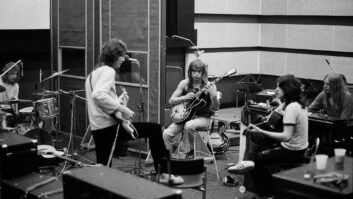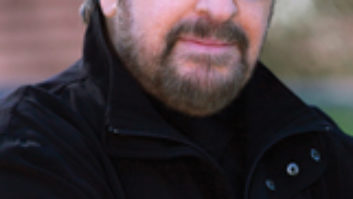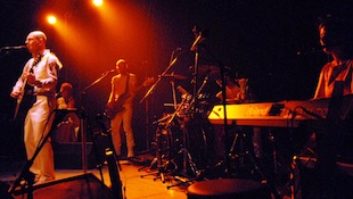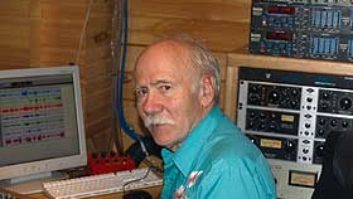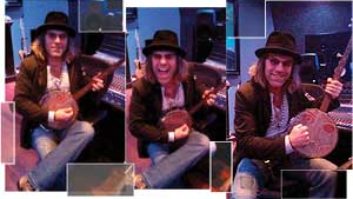Los Angeles, CA—Morrissey will release his tenth studio album in July, World Peace is None of Your Business, which was recorded in France in February with producer Joe Chiccarelli. The new project, his first for a new two-album deal with Capitol, comes hard on the heels of his memoir, Autobiography, published in October 2013, and spawned a seven-week U.S. tour that is scheduled to end in New York on June 21.
Longtime Morrissey FOH engineer David “Milky” Millward mixes the former Smiths frontman on an Allen & Heath iLive-80. U.K.-based FOH engineer David “Milky” Millward, who has been working with Morrissey since 2004, has developed a compact, networked mix setup that positions an Allen & Heath iLive-80 control surface and PL10 rotary fader plate module, two laptops, an iPad and an iPod Touch all within arm’s reach. The system is interconnected via A&H’s proprietary ACE and Audinate’s Dante networks with Wi-Fi for the handheld devices.

“Because I’ve got a Wi-Fi router, I can connect the iPod Touch for playback and remote-control it from the iPad. So when I’m walking around the room setting the system up, I can be on the third balcony and decide I want to listen to a different track,” says Millward.
At the other end of the redundant Cat5 snake connecting Millward’s iLive to the A&H iDR10 MixRack on-stage, German monitor engineer Tom Vollmers, who previously worked with Morrissey on his 2011 world tour, is using an iLive for the first time. In fact, says Vollmers, “I did a tour in Germany last month and used the iLive-112 because I knew I was using it for Morrissey. It’s good sounding, I like the surface and the effects are pretty good.” Production provider Eighth Day Sound supplied a d&b technologies Q series sound system for the tour.
Because of the size of the L.A. Sports Arena, N. Hollywood-based Schubert Systems was brought in to supplement the rig. “It’s 12 J8s a side with four J12s underneath, six J Subs flown per side, with 12 V8s per side for out fill,” enumerates Michael Mordente, A1/system designer for Schubert Sound. “There are four V2 Subs per side, and four J Subs per side, on the ground, with four Qs for lip fill. A total of 48 D12 amplifiers are powering it, with three Lake LM44s running AES processing it, plus the [d &b] R1 control system.”
Vollmers’ monitor mixes for Morrissey and the two guitar players fed d&b M2 wedges. “One of the best in the world,” he says. “We’re using L-Acoustics Arcs side fills, stacked on L-Acoustics SB28 subs.” The bass player and keyboard player were both on Sennheiser G3 IEMs, while the drummer made use of a G3 IEM plus two wedges.
Millward says of the iLive-80, “It’s 20 faders on the surface, with four layers, so you’ve got 80 faders at any one time. For each song, even if I’m not doing any automation or any changes at all, the one thing I will do is bring up the faders I need for that song to the surface. Plus, I do a lot of mixing on the DCAs.”
Using one song’s set-up by way of example, he elaborates, “At this level, I’ve brought up the kit reverb, snare top and bottom, acoustic guitar and the backing vocals I need. I always have [Morrissey’s] vocal accessible.”
Morrissey took to the stage at the L.A. Sports Arena, belting into his Shure KSM9HS mic as he tread upon a d&b audiotechnik M-Series wedge. In the distance, monitor engineer Tom Vollmers oversaw an Allen & Heath iLive-112 console at stageside. His left-hand laptop runs iLive Editor, which he uses to configure and program the surface. “You go into Strip mode and you can select one or multiple things and drag them. It can be anything—an input, an output, a DCA, an effects return, stereo group. So you’ve got a lot of flexibility. You can do that on the surface as well, but I tend to use the Editor.”

Every Morrissey show is archived to the laptop on Millward’s right: “I’m using Logic to record to a solid state drive. I’m using the Dante card in the MixRack and the Dante Virtual Sound Card just to do record and playback. So I can do virtual soundchecks, as well.”
Also by Millward’s right hand is an A&H PL10 wall panel, originally intended as an installed sound product. “But it’s ideal,” he says. “It adds a load of quick-access keys, assignable to various functions. So I have instant access to the effects slots.” Four of the iLive surface quick keys also access effects.
“The plug-in culture is a bit of a pet hate of mine, partly because, coming up through analog, I never had access to any of that,” he says. “So I don’t understand this obsession with plug-ins.”
However, the processing—including EQ, reverbs and compressors— in the iLive is very usable, he says. “It has the best built-in reverbs of any console I’ve come across—and I’ve used most of them. I’ve found with so many effects that I’m having to EQ the reverbs and hack nasty frequencies out. But I hardly ever have to touch these, which says a lot for the smoothness and attention to detail.”
Millward has programmed two PL10 switches for PFL. “From the matrix, a copy of my mix is going into the Dante bus. When I have Logic up on the laptop and I press record, I can hear my audience mics on one switch and the mix on another. They don’t appear on the surface but I have them here.”
Neither Morrissey, the band nor the crew have endorsements with any microphone manufacturers, so Millward has simply amassed a variety of brands and models that are best suited to the job. “But I’ve been around so long that I know people,” he says. “So as far as Shure is concerned, I’ve known Peter James, the managing director of Shure distribution U.K., since he walked into the music shop where I was working as manager when he was selling Studiomaster desks. If I want to try anything, he’s good at letting me try—and everything I’ve tried, we’ve bought.”
In the US, Millward previously had Morrissey on a Shure KSM9. “Now we’re using the KSM9HS,” he reports. “They’re absolutely fabulous. We use it on the hyper-cardioid setting. It’s made a big difference.”
When Millward first signed on with Morrissey, the singer was using a Shure Beta 58 or 58A, he recalls. “It was when the Neumann 105 came out. We rented one when we did five nights at the Wiltern in L.A. and five nights at the Apollo in New York. He liked it, so we used the Neumann for a long time.”
Unfortunately, the 105s didn’t stand up well to rough handling. “Sennheiser eventually said they couldn’t keep repairing them. We owned about eight, and at any one time, there were three or four being repaired.”
He continues, “Peter also lent me a whole kit when they brought out the Beta 98As. [U.K. production company] SSE ended up buying practically all of it and we use them as standard.”
He adds, “In the U.K., Shure Distribution also distributes Radial, so I tried all those lovely Radial boxes, like the JDX, the stereo DI, before we bought them. It’s great stuff and built so well.”
As for the rest of the stage, in addition to various Sennheiser and AKG models, “We’re using the Shure SM57, SM81 and a Beta 91A on the bass drum. Since that came out, I haven’t used two mics on the bass drum.” He adds, “As long as the bass drum is good, anyway.”
Looking over his equipment at front of house, he says, “It was a revelation when I first found an app that could remote control the music on the iPod from the iPad. When technology just works every day and it plays together nicely, that makes life really easy.
“Now I always have a Wi-Fi router with me. Apart from that, the most important things are the kettle and the teapot, really!”
Allen & Heath
allen-heath.com
d&b audiotechnik
dbsound.com


